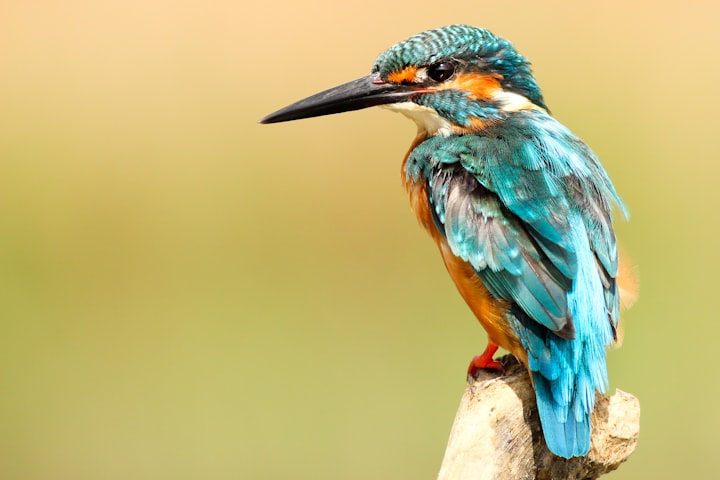"The Beauty of Plumage: A Look at Bird Coloration"
Camouflage and Display: The Dual Roles of Feather Colors

Birds are nature's living canvases, with their varied and captivating plumage. Scientists, nature lovers, and birdwatchers are all enthralled with these creatures due to the astounding variety of colors, patterns, and textures found in their feathers. Birds use their rich coloring for a variety of purposes in their lives, such as communication, concealment, mate attraction, and evolutionary insight. We will dig into the fascinating realm of bird colors in this piece, examining the meaning, art, and science of these vivid displays.
Bright Colors and Designs
The range of colors displayed by birds is astounding, ranging from the flamboyant red of the Northern Cardinal to the shimmering blues and greens of hummingbirds. These hues are not just a random mix but a product of intricate pigmentation and light interaction. Bird feathers derive their colors from two primary sources: pigments and structural colors.
Pigments, such as melanin and carotenoids, impart a wide range of colors to feathers. Melanin produces black, brown, and gray colors, while carotenoids are responsible for reds, yellows, and oranges. Some birds, like flamingos, get their pink color from a diet rich in carotenoid-rich algae and crustaceans.
Structural colors, on the other hand, are created by the way feathers are structured and interact with light. For instance, the striking blue feathers of a Blue Jay are not actually blue but appear so due to microscopic structures that refract and scatter light, creating the illusion of color. This structural coloration gives rise to the shimmering and iridescent plumage seen in hummingbirds, peacocks, and other species.
The Evolution of Bird Plumage
The evolution of bird plumage is a testament to nature's creativity. Over millions of years, feathers have evolved in response to selective pressures. For some birds, the coloration serves a dual purpose: it acts as both camouflage and a means of communication. The cryptic coloration of owls and nightjars helps them blend seamlessly with their surroundings, making them nearly invisible to predators and prey alike.
Conversely, male birds often display vibrant plumage to attract females. The brilliant colors of male birds, such as the resplendent quetzal and the peacock, are prime examples of how sexual selection has driven the evolution of ornate plumage. Bright colors signal good health, vitality, and the ability to provide for offspring, making them irresistible to potential mates.
Camouflage and Display
For many birds, blending into their surroundings is crucial for survival. The intricate patterns and colors of species like the woodcock and potoos help them stay hidden from predators during the day. Some birds, like the American Woodcock, even perform displays that mimic the dappled light on the forest floor, adding an extra layer of camouflage.
On the flip side, birds also use their plumage to make a statement. Mating displays involve extravagant shows of color and feather arrangements. Take, for example, the striking courtship dance of the Sage Grouse. Males fan their tail feathers and puff up their white chest plumage in an elaborate display that is nothing short of a visual spectacle, all to win the favor of females.
Adaptive Coloration
Birds have developed diverse adaptations in their plumage to suit their ecological niches and lifestyles. Some birds have specialized colors to exploit unique feeding strategies. The bee-eater, with its brilliant plumage, often catches and consumes stinging insects like bees and wasps. Its vivid colors send a warning to potential predators that it is equipped to handle venomous prey.
Seasonal Wardrobe Changes
Many birds undergo molting, a process of shedding and replacing feathers. This process plays a critical role in maintaining the integrity and functionality of their plumage. For some species, molting can also result in seasonal changes in coloration. The American Goldfinch, for example, molts into its bright yellow plumage during the breeding season, while it sports a more subdued olive-brown plumage in the winter.
Hidden Messages
Birds use coloration to communicate with one another. Color can signal aggression, submission, territory ownership, or readiness to mate. In some cases, species have developed complex social systems and rituals that involve color displays. For example, male Eastern Bluebirds exhibit aggression by displaying bright blue colors to rivals, while females use their muted coloration to signal their readiness to accept a mate.
Cultural Significance
Bird coloration has not only intrigued scientists but also inspired artists, poets, and cultures throughout history. In many traditions, birds and their vibrant plumage have been symbols of beauty, freedom, and spirituality. The vivid hues of birds have adorned paintings, textiles, and jewelry, and their symbolism can be found in myths, legends, and folklore across the world.
Conservation and Threats
The beauty of bird plumage also underscores the importance of conservation. Many bird species are threatened by habitat loss, pollution, climate change, and poaching. Protecting these remarkable creatures and their vibrant colors is not only an ecological imperative but also a commitment to preserving the natural world's astonishing diversity.
Conclusion
The world of bird coloration is a testament to the intricate and captivating beauty of the natural world. From the vibrant hues of tropical birds to the subtle camouflage of forest dwellers, the colors of birds serve multiple functions, from survival to courtship. Their plumage tells stories of evolution, adaptation, and the delicate balance of nature. Birdwatchers, scientists, and enthusiasts alike are drawn to these living canvases, forever in awe of their stunning displays. As we celebrate the beauty of plumage, let us also remember our responsibility to protect and preserve these feathered wonders for generations to come.





Comments
There are no comments for this story
Be the first to respond and start the conversation.